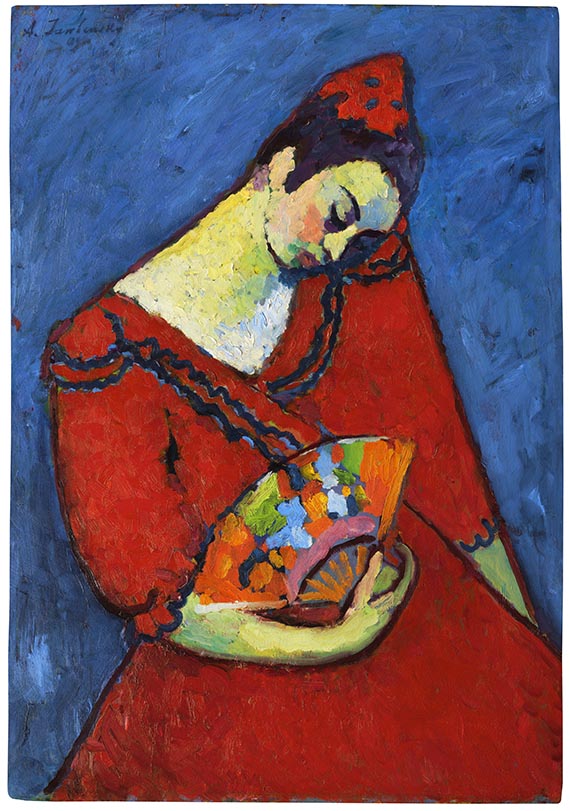Dictionary


The 'Murnau' artists
Wassily Kandinsky had discovered the small village of Murnau, idyllically located on the Staffel Lake and the swampy Murnauer Moos, during an excursion as early as in 1904, but it would take another four years until he spent the first summer there, together with Gabriele Münter, Alexej von Jawlensky and Marianne von Werefkin, similar to the artists' colonies of former days. The Murnau days of the four artist, which would later form the core of the group "Blauer Reiter" (Blue Rider) lasted until 1914 and were decisive for the development of Modernism, as this was where the artists attained a consolidation of their surface compositions and more powerful ways of expression and abstraction in their works.
Looking back, Gabriele Münter wrote in her diary that in Murnau she had "made a great leap after a short time of agony - from a plain depiction of nature - to a more or less impressionist way of feeling the content, to an abstraction, to give what is essential." Alexej von Jawlensky also found his way from impressionist speckle painting to expressive surface painting, likely to have been inspired by the landscape formations around Murnau. Wassily Kandinsky's development was the quickest and most intensive, as he performed the step to abstraction in Murnau. Marianne von Werefkin worked up the impressions of the Muranu landscape in her very own symbolic-gloomy manner. However, it was not only nature that the artists were attracted by, but also Murnau's folk art, finding inspiration in the rural reverse glass paintings with its lucent colors and simplified forms.
Franz Marc went to the town of Sindelsdorf, some 20 km away from Murnau, in 1910, however, he wouldn't get to know the four Murnau artists in Munich before December the same year, which then soon led to the formation of the group "Blauer Reiter" (Blue Rider).
Wassily Kandinsky had discovered the small village of Murnau, idyllically located on the Staffel Lake and the swampy Murnauer Moos, during an excursion as early as in 1904, but it would take another four years until he spent the first summer there, together with Gabriele Münter, Alexej von Jawlensky and Marianne von Werefkin, similar to the artists' colonies of former days. The Murnau days of the four artist, which would later form the core of the group "Blauer Reiter" (Blue Rider) lasted until 1914 and were decisive for the development of Modernism, as this was where the artists attained a consolidation of their surface compositions and more powerful ways of expression and abstraction in their works.
Looking back, Gabriele Münter wrote in her diary that in Murnau she had "made a great leap after a short time of agony - from a plain depiction of nature - to a more or less impressionist way of feeling the content, to an abstraction, to give what is essential." Alexej von Jawlensky also found his way from impressionist speckle painting to expressive surface painting, likely to have been inspired by the landscape formations around Murnau. Wassily Kandinsky's development was the quickest and most intensive, as he performed the step to abstraction in Murnau. Marianne von Werefkin worked up the impressions of the Muranu landscape in her very own symbolic-gloomy manner. However, it was not only nature that the artists were attracted by, but also Murnau's folk art, finding inspiration in the rural reverse glass paintings with its lucent colors and simplified forms.
Franz Marc went to the town of Sindelsdorf, some 20 km away from Murnau, in 1910, however, he wouldn't get to know the four Murnau artists in Munich before December the same year, which then soon led to the formation of the group "Blauer Reiter" (Blue Rider).
Offers
Headquarters
Joseph-Wild-Str. 18
81829 Munich
Phone: +49 89 55 244-0
Fax: +49 89 55 244-177
info@kettererkunst.de
Louisa von Saucken / Undine Schleifer
Holstenwall 5
20355 Hamburg
Phone: +49 40 37 49 61-0
Fax: +49 40 37 49 61-66
infohamburg@kettererkunst.de
Dr. Simone Wiechers / Nane Schlage
Fasanenstr. 70
10719 Berlin
Phone: +49 30 88 67 53-63
Fax: +49 30 88 67 56-43
infoberlin@kettererkunst.de
Cordula Lichtenberg
Gertrudenstraße 24-28
50667 Cologne
Phone: +49 221 510 908-15
infokoeln@kettererkunst.de
Hessen
Rhineland-Palatinate
Miriam Heß
Phone: +49 62 21 58 80-038
Fax: +49 62 21 58 80-595
infoheidelberg@kettererkunst.de
We will inform you in time.




